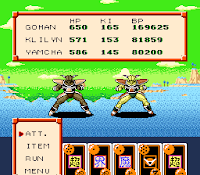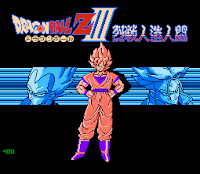Hyper
Dimension
I hated this game as a kid. But then, I also loved Final Fantasy
Mystic Quest as a kid.
Hyper Dimension is, to me, unarguably the best of the Super Famicom
Dragon Ball titles and easily one of the best Dragon Ball Z video
games ever made. So, obviously, my opinion has changed drastically
since I first played it.
Like Super Butouden 2, this game also introduced me to something: Emulator limitations.
For a considerable amount of time, the most popular Super Nintendo
emulator, ZSNES, could not run Hyper Dimension. That forced my
brother and myself to seek out another emulator. We found Snes9x
and, funnily enough, the site we found it on specifically claimed
something like “Yes, this plays Hyper Dimension”.
The most current ZSNES runs the game no problem and it's been able to
for a long time now. I'm just taking a bit of a stroll down
Nostalgia Way.

 This
game did so much to set it apart from the Super Butouden series while
still maintaining the same basic control scheme to make it accessible
for people who had played that series. Almost everything new Hyper
Dimension introduced, it got it right. And here's where I feel like
a hypocrite because Hyper Dimension is actually a considerably slower
game than Butouden 3. However, it's a bit faster than Butouden 2 and
the overall gameplay compliments the speed of the game.
This
game did so much to set it apart from the Super Butouden series while
still maintaining the same basic control scheme to make it accessible
for people who had played that series. Almost everything new Hyper
Dimension introduced, it got it right. And here's where I feel like
a hypocrite because Hyper Dimension is actually a considerably slower
game than Butouden 3. However, it's a bit faster than Butouden 2 and
the overall gameplay compliments the speed of the game.
The new mechanics that bothered me in my youth are the fusion of
health and energy, and the new flight system. Really, they only
bothered me because at the time I was used to the Butouden games and
just wanted more of the same.
Health and energy/Ki are the same thing in this game. You actually
hurt yourself when using energy-based attacks. You also heal
yourself by charging. This is one mechanic that I think is very
complimented by the somewhat slower speed of Hyper Dimension; it's
something you really have to think about how you're timing. It is
also true to the anime and manga where Ki/chi/energy/whatever is
specifically defined as the 'life energy' of all living things; in
fact, both Vegeta and Tien at some point die in the anime by
expending all of the energy they had left into a final attack.
Although, in Hyper Dimension, you can't KO yourself by using too much
energy, once you reach 1 point of health, you're just no longer able
to use energy-based attacks (except for basic fireballs which never
cost any health/energy to use in these games).
Hyper Dimension also introduces real-time control over the strength
of your beams. In the Super Butouden trilogy, executing an energy
wave while being near your opponent would result in a weak version of
the attack; you needed to be further away to execute the full-power
version. The typical main beam button input for all of these games
is Down Back Forward A. Hyper Dimension instead lets you hold down A
at the end of the input and shows the energy growing in the
character's hand, reaching a max and then resetting; so you control
the strength of your attack by letting off of the A button at the
right time.
Sadly, Hyper Dimension does not feature beam battles; when energy
waves of the same strength meet, they cancel each other out. When
energy beams of variable strength meet, the weakest one is cancelled
and the stronger one continues on.
 Since Hyper Dimension no longer uses the X button to toggle between
the sky and the ground, it's now both the Throw button and the Swat
button. Throwing is exactly what you expect it to be. Swatting
works as a weak punch (if you're close enough to the opponent to hit
but not close enough to throw them) but it can also be used to
deflect weak energy attacks like simple fireballs.
Since Hyper Dimension no longer uses the X button to toggle between
the sky and the ground, it's now both the Throw button and the Swat
button. Throwing is exactly what you expect it to be. Swatting
works as a weak punch (if you're close enough to the opponent to hit
but not close enough to throw them) but it can also be used to
deflect weak energy attacks like simple fireballs. Characters have unique signature moves and also have 'Desperation
Moves', one of my favourite new mechanics in this game. Once you
reach critically low health, your health bar will start blinking red.
While in this state, you can execute your character's ultimate
attack, or Desperation Move. Some of these have very tricky button
combinations but they're nice to have all the same; Vegeta's being
especially cool.
Characters have unique signature moves and also have 'Desperation
Moves', one of my favourite new mechanics in this game. Once you
reach critically low health, your health bar will start blinking red.
While in this state, you can execute your character's ultimate
attack, or Desperation Move. Some of these have very tricky button
combinations but they're nice to have all the same; Vegeta's being
especially cool.
The only new mechanic in Hyper Dimension that I think is outright bad
is the inclusion of background attacks. Each character has a
maneuver where they jump towards the background, leaving the usual
playing field, and charge back to the field with a punch or kick.
These are strong attacks and most, if not all, of them are guaranteed
to knock down the opponent when they hit. However, they'll almost
never hit. Because Hyper Dimension is a relatively slow game,
responding to an attack with this kind of complex animation is
extremely easy. These 'background depth attacks' telegraph
themselves horribly and are really just useless.
There are no secret characters in this game, the roster goes Goku
(Super Saiyan 2), Majin Vegeta, Super Vegito, Gotenks (Super Saiyan
3), Piccolo, Perfect Cell, Frieza, Ultimate Gohan, Fat Buu, and Kid
Buu.
The game, like the Butouden series (2 specifically), features a story
mode, a versus mode, and a tournament mode. The story mode is a
little strange because it attempts to cover the entirety of Dragon
Ball Z while working around characters that aren't in the game. For
instance, the Saiyan saga is plainly skipped only giving a passing
mention to the fight with Vegeta, and the first battle is actually
Piccolo versus Frieza. Later on, you play as Majin Vegeta against
Perfect Cell which never happens in the anime but is meant to be the
game's rendition of Super Vegeta versus Semi-Perfect Cell.

Also,
did I mention that this game is downright gorgeous? Hyper Dimension
is one of the best looking 16-bit era games there is. Speaking of which,
if you're going to play it on ZSNES, do not use the Super
Eagle Engine. That rounding
filter may look nice on games like A Link to the Past and whatnot but
Hyper Dimension has so many pixel-art gradients that it actually
looks worse with the filter on.
 Everything
in the game is incredibly, meticulously detailed. The only fault I
can find with the game's graphics is the fact that because everything
is just so detailed, it's one of a small handful of games that shows
that the Super Famicom/SNES does have a limit to its colour palette.
Goku's Super Saiyan hair for instance looks to be mostly drawn with
the same shades as his skin; both being a gold-ish tan.
Everything
in the game is incredibly, meticulously detailed. The only fault I
can find with the game's graphics is the fact that because everything
is just so detailed, it's one of a small handful of games that shows
that the Super Famicom/SNES does have a limit to its colour palette.
Goku's Super Saiyan hair for instance looks to be mostly drawn with
the same shades as his skin; both being a gold-ish tan.
The colours in the column on the left were 'pick-coloured' from his hair and the colours in the right column are from his face. A couple were reused and a couple are unique.
The game is also flexible in whether or not you want a fight to span multiple stages, featuring a 'single-stage' mode where you don't have to select stages in full sets and Dimension Kicks no longer traverse the additional areas.
Dragon
Ball Z: Hyper Dimension feels very much like it was game built from
the ground up to be a very good fighting
game first, and a very
good Dragon Ball game
second. I have absolutely no complaints about that approach. This
is the one standout of the Super Famicom titles that's worth playing
no matter what your opinion on the franchise. Honestly, there's still more I could say about the game and I might even try to do a more thorough dedicated review for it in the future. But for now, I need to move on.
Unfortunately, unlike the Super Butouden trilogy, Hyper Dimension was never released outside of Japan. However, if you're like me and own a device that can play Super Famicom games (a Retro Duo in my case), then you can actually find some pretty decently priced copies on eBay, ranging from $10-$50 depending on condition and whether or not there's a box.
Next Time: Sega Genesis/Mega Drive and Sony Playstation.



































